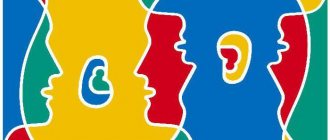negotiation
02.07.2020
Author: Academy-of-capital.ru
Add a comment
Rating:
| (Votes: 2, Rating: 4) |
From this material you will learn:
- Description of Verbal Communication
- Differences between verbal and nonverbal communication
- Types of Verbal Communication
- 4 Barriers to Verbal Communication
- Secrets of success in business verbal communication
- Techniques of business verbal communication
- 5 mistakes in mediated communication
Verbal communication is one of three ways of exchanging information between people, which begins from a person’s birth and lasts throughout his life. In childhood, the child expresses his needs, and in adulthood, verbal communication is necessary to solve everyday and business problems.
Despite the fact that communication is an integral part of life, the effectiveness of verbal communication is far from 100%. It is generally accepted that approximately 80% of the intended volume of information can be expressed, but another part will be lost “on the other side” - the interlocutor will perceive approximately 60–70%. Moreover, if you make mistakes in verbal communication, then the chances of correctly conveying what you want are small.
Verbal communication in psychology
The deaf and dumb also speak, but through gestures. You can speak out by changing your body position, facial expressions, and gaze. All these are methods of non-verbal contact.
Verbal communication is the transmission and reception of information through speech (it does not matter whether it is oral or written). Not all people understand sign language, but the sign system using words is accessible to most.
As a child, a person learns to communicate using speech as the most accessible and understandable way to express his desires and convey important information to his interlocutor. Phrases spoken out loud are more obvious than attempts to explain something with gestures. The power of words helps interlocutors hear and understand each other.
Formation of communication skills
Without verbal communication, a person feels locked in a “shell of loneliness.” The lack of communication skills will not give you the opportunity to explore the world, improve and reach certain heights.
Speech has a number of features that allow people to interact with each other. These characteristics highlight the importance of communication.
Components of verbal communication
| Name | Peculiarities |
| General | Even when communicating at a distance (on the phone), you can get some information about the interlocutor from your voice, intonation, and spoken phrases: gender, approximate age, temperament, health status, etc. |
| Personal | Any conversation evokes emotions, setting up positive contact, or provokes indignation. With some you want to communicate, with others it is better to immediately interrupt the conversation |
| Emotional | Communication is a way of self-expression, an opportunity for harmonious development. You can get information from books, textbooks, television. Mutual communication helps to receive emotions and find a response to one’s own feelings and thoughts. |
The people around them have common preferences or different views on life - this does not prevent them from contacting each other. Speech helps build relationships (family, neighborhood, work) and is a tool for achieving one’s own goals.
Human facial expressions
Human facial expressions are also a way of informing. When the face is immobile, 10-15% of all information is lost. If a person is deceiving or hiding something, then his eyes meet the eyes of the interlocutor less than a third of the time of the entire conversation. The left side of a person's face is more likely to show emotions. Accurate messages about a person's condition are conveyed through the eyes or the curvature of the lips. This occurs due to the behavior of the pupils - their contraction and dilation is beyond our control. When we experience the emotions of fear or sympathy, the pupils characteristically change.
How verbal communication is used
Verbal speech is called a sign system of communication, in which the meaning of the transmitted or received message is not lost. It is based on two principles:
- a set of words of a particular language (this is vocabulary);
- rules for creating speech units (syntax).
Monogamy - what is it, who is it
In psychology, speech and thinking are inseparable, because the first is the form of existence of the second. When people communicate with each other, it happens according to this pattern:
- the speaker mentally selects certain words;
- using the rules of vocabulary and syntax, forms phrases from them;
- only then says them out loud;
- the interlocutor, having heard what was said, decodes the information for mental perception and creates his own images in his head.
Note! Even with clear transmission of information, distortions and semantic losses are possible, which amount to about 60%.
If the sentence was composed according to the rules of grammar, there will be no difficulties in communication. But only when people speak a language that each other understands.
How to reach your interlocutor
The same applies to written speech. To receive information from printed publications (or at least read SMS), a person must speak this language. To put your thoughts on paper (type text on a keyboard), you need not only to be able to speak, but also to write.
Spoken or written words help to analyze objects, events and phenomena, to find main and secondary signs in them. Naked, concrete facts are inherent in business speech. For emotional contact, verbal additional means are needed:
- voice modulation, intonation, pauses, rhythm in oral speech;
- the sweep of the handwriting and the angle of inclination, the force of pressure and the direction of the lines in the letter.
These expressive characteristics make it possible to understand how the correspondent himself feels about the message and the person with whom he is communicating.
Flexibility of speech
One of the important characteristics of verbal communication is the flexibility of speech, which varies from person to person and depends on the character and conditions in which he grew up and was brought up. Someone has a rich vocabulary, replete with adjectives, and knows how to express their thoughts brightly, interestingly and effectively. Another prefers to say little, uses short, inexpressive phrases, but sentences that are very specific in meaning, does not overuse epithets and rarely flaunts beautiful speeches.
It cannot be said that the second is bad and the first is good, since this is just a way of communication and a toolkit, and often the same thought can be expressed either flowery and verbose, or simply, without decoration.
But the fact remains: in a society based on interaction, built on constant communication between people, people with good speaking skills are usually favored.
Types of Verbal Communication
Active listening - what is it in psychology
Verbal means of communication are speech, which in action is divided into 2 types: “speaking-listening”, “writing-reading”. In other words, speech is divided into oral and written. Each of them, in turn, is divided into components.
Types of speech
| Name | Definition |
| Oral | |
| Dialogue | Characteristic is a consistent change in the roles of communicating individuals, whose speech has a certain meaning. By exchanging phrases, the interlocutors make it clear to each other that they understand the essence of what the recipient said |
| Monologue | A prolonged statement by one person, uninterrupted by others (example - lecture, report, campaign speech, product presentation, etc.) |
| Written | |
| Direct | Correspondence in real time is carried out via SMS messages, exchange of notes in class, etc. |
| Deferred | Communication via paper or email |
Written form of communication
There is another type of speech - dactyl, which is used by blind and deaf-mute people. The signs used in it are a manual alphabet that replaces the usual letters.
Oral and written speech are classified as external, the existence of which is unrealistic without internal speech. It is formed in a person’s head before the individual voices it or writes it.
Video
Drill-driver DEKO GCD12DU3 Li-ion, 1x1.5Ah, Replaceable battery, 12 V, 32 Nm, 1 battery
1697 ₽ More details
Drill/driver DEKO DKCD16FU Li-ion in case + 63 accessories, 2x1.5Ah, Replaceable battery, 16 V, 32 Nm, 2 batteries
3168 ₽ More details
Nail design
Language and its functions
Social needs - what are they?
Language does more than just express people's thoughts and feelings. It is impossible to imagine any aspect of life where speech is not used.
Language functions
| Name | Definition |
| Communicative | Provides interaction between people, allowing you to fully communicate with others like you |
| Rechargeable | The ability to accumulate and store knowledge, passing it on to descendants (notebooks, notes, fiction and scientific literature) |
| Cognitive | Language helps to gain knowledge from books, films, scientific treatises, lectures, etc. |
| Constructive | Makes it possible to put a thought into an accessible, understandable, conscious form for others in the form of written or verbal expression |
| Ethnic | Unites people not only into groups of the same nationality. Through language communication is possible between peoples around the world |
| Emotional | Using words you can convey your feelings and emotions to your interlocutor. |
To successfully use the functions of language in one’s own life, a person must learn to communicate and build relationships. The ability to speak is influenced by knowledge of one’s own and foreign languages, rules of speech production, as well as the mental aspect. Some people are prevented from communicating by fear of contact with other individuals. Inaction only makes the situation worse.
Rules of Verbal Communication
To achieve the desired result in the development of relationships, you should take into account some points and put them into practice:
- it is necessary to show goodwill and respect for the interlocutor;
- do not impose your point of view on the issues under discussion and tactfully avoid “sharp corners”;
- maintain logic in statements and consistency in conversation;
- build a conversation on short remarks and the optimal amount of information;
- present truthful information relevant to the subject of conversation;
- take into account in communication the nationality, social status and attitude of the interlocutor to the subculture.
Learn to communicate
In dialogue, it is important to maintain the order of statements. A person who interrupts the speaker for no reason emphasizes with such behavior the low level of his own speech culture.
Features of nonverbal communication
In communication without words, everything is important: how a person holds his back (posture), at what distance he is, what gestures, facial expressions, postures, glances he has, and so on. There are certain areas of nonverbal communication that determine the effectiveness of communication.
- Public - more than 400 cm from the informant; such communication is often used in classrooms and during rallies.
- Social - 120-400 cm distance between people, for example, at official meetings, with people we don’t know well.
- Personal - 46-120 cm, conversation with friends, colleagues, there is visual contact.
- Intimate - 15-45 cm, communication with loved ones, you can speak quietly, tactile contact, trust. If this zone is forcibly violated, blood pressure may increase and the heart rate may increase. This phenomenon can be observed in a very full bus.
Verbal and nonverbal communication are processes that will help achieve effectiveness in negotiations if these zones are not violated.
How to Make Verbal Communication Effective
Thanks to communication, people coexist in this world, achieving certain heights in life. In order for communications to give positive results, and for others to want to communicate with a specific person, it is necessary to adhere to a number of principles:
- With your attention and interest, evoke a strong desire in your opponent to communicate.
- Evaluate people and events sincerely and honestly.
- Don't complain, judge or criticize.
- Show interest in your interlocutor, talk about things that are important to him.
- Learn not only to clearly express your thoughts, but also to listen carefully to your opponent’s speech.
Important! A thought poorly expressed can be misinterpreted. But inattentive listening also distorts the meaning of the information received. The ability to speak and listen are two components of communicative communication.
Interest in the interlocutor
- It is important not only what is said, but also how the words are pronounced. For the interlocutor, emotions and paraverbal signals (articulation, speed, tonality and accompanying sounds) present in speech can mean more than the spoken phrases.
There are people who can think clearly, but are not able to formulate phrases in oral speech. Others speak well, but have difficulty putting words into written form. Or vice versa - they present it beautifully on paper, but are tongue-tied in oral communication.
To achieve harmony in all types of verbal speech, you need to improve your abilities, overcoming psychological barriers.
Comparison
As follows from the definitions, the main difference between types of communication lies in the method of transmitting information. Verbal communication refers to the use of spoken or written language. That is, interlocutors exchange information, putting it into words. This type of interaction is typical only for people. The basis of nonverbal communication is body language. The main tools of communication in this case are gestures, postures, facial expressions, and touches. With their help, a person can say a lot without even using speech. At the same time, the language of facial expressions and gestures is inherent in both people and animals. For example, a dog expresses its joy by wagging its tail, while a cat, on the contrary, expresses irritation. An animal grin is a warning signal, and a guilty glance from under his brows is a sign of repentance. And there can be many such examples.
Surprisingly, nonverbal communication is much more truthful than verbal communication. The fact is that often we are simply not able to control our gestures and facial expressions. They seem to come from within and become a reflection of our true feelings and experiences. Oral and written speech can be deliberately false. It is much easier to deceive a person during a telephone conversation or online communication than when talking with him in person. Indeed, in the latter case, it is possible to follow the opponent’s facial expressions and gestures and notice their discrepancies with speech. For example, if the interlocutor presents his version of events without looking you in the eye and nervously fiddling with an object in his hands, it means that he has something to hide. Thus, it is much easier to deceive with words than with facial expressions and gestures.
Another difference between verbal and nonverbal communication is the perception of information. For example, in order to correctly grasp the meaning of the interlocutor’s speech, we need to use our mind and logic. Whereas when recognizing gestures and facial expressions, intuition comes to the rescue. One more point: if during verbal interaction between people a speech barrier may arise in the form of cultural or national differences, misunderstanding of the meaning of certain terms, then in the case of non-verbal communication this rarely happens. After all, regardless of a person’s location, his open, wide smile will be perceived as a sign of cordiality and friendliness, and a wave of his hand will become a symbol of greeting. Of course, overcoming the speech barrier can sometimes be very difficult. But once in a foreign country, we can always communicate with local residents using gestures, which indicates the high efficiency of such communication.
To summarize, what is the difference between verbal and non-verbal communication.
| Verbal communication | Non-verbal communication |
| Involves the use of spoken or written language | It's all about body language |
| Words are the main instrument | Built on facial expressions, gestures, touches |
| Can be deceitful and insincere | Becomes a reflection of our true feelings and experiences |
| Can be controlled by humans | Often acts as an unconscious manifestation |
| To perceive information you need to use your mind and logic | When recognizing gestures, intuition comes to the rescue |
| A speech barrier often arises between people due to a lack of understanding of the meaning of what was said. | Highly effective and easy to interpret |
| Only human | Characteristic of both humans and animals |
What do languages have in common?
A person uses two types of communication in life. Nonverbal language is not the prerogative of the deaf and dumb. It can be called an external manifestation of brain activity. Before even starting to pronounce phrases out loud, an individual can involuntarily hint about the course of his thoughts through facial expressions, body posture, and gaze.
But the interlocutor may misinterpret such signals, or the individual may deliberately distort the information conveyed by body language. To understand a partner and obtain more complete information, verbal contact is also required for analysis.
Nonverbal and verbal means of communication carry certain information transmitted to the interlocutor and are a way of organizing feedback. At the same time, body language can complement the verbal message, strengthening it, or, conversely, contradict what was said.
Intonation, timbre and rhythm of the voice are elements of non-verbal language. At the same time, these characteristics are a component of verbal communication. With their help, it is easy to change the meaning of a spoken phrase. But other signs of the body, if not controlled, will unconsciously “debunk” the falsity of the statement.
Verbal speech and body language in harmony
To prevent communication from boring your partner, both languages must be balanced. Monotony, unemotional speech, and excessive gestures interfere with the perception of information and can alienate the interlocutor.
Misunderstandings not only lead to disappointment in relationships, but also to serious conflicts. This manifests itself at any level: in family, business, business communication, thereby complicating life. Having learned to master body and verbal language, bringing both types of communication into harmony, a person will achieve great success in any field.
Features of speech communication processes
Processes of verbal communication may occur with certain difficulties. Since two or more people take part in such communication, with their own interpretation of the information, unforeseen tense moments may arise. Such moments are called communication barriers. Both verbal and nonverbal means of communication are subject to such barriers.
- Logical - a barrier at the level of logic of information perception. It occurs when people with different types and forms of thinking communicate. The acceptance and understanding of the information provided to him depends on a person’s intelligence.
- Stylistic - occurs when the order of the information provided is violated and its form and content do not correspond. If a person starts the news from the end, the interlocutor will have a misunderstanding of the purpose of its presentation. The message has its own structure: first the interlocutor’s attention arises, then his interest, from there comes a transition to the main points and questions, and only then a conclusion from everything said appears.
- Semantic - such a barrier appears when people from different cultures communicate, there is a discrepancy between the meanings of the words used and the meaning of the message.
- Phonetic - this barrier arises due to peculiarities of the informant’s speech: unclear speaking, quiet intonation, shift in logical stress.









